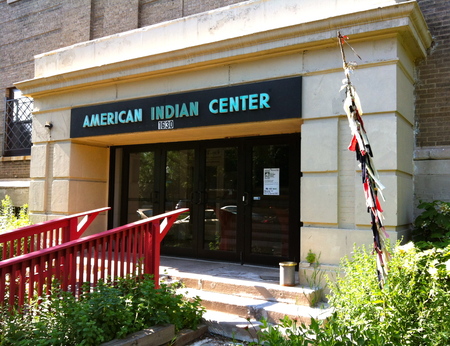Booming M80s in Chicago announced that the Blackhawks -- named for the Sauk warrior who fought during the Black Hawk War of 1832 -- had won the Stanley Cup last Tuesday. A few days later, 2 million people made their way downtown to watch the celebratory parade.
The mass of people created a primarily red, white, and black sea through Grant Park. From my desk, I skimmed through the Chicago Tribune's photos, and a few stood out from the rest -- one of a guy wearing nothing but a rainbow headdress and loincloth; another with war paint dripping down his face; and these ladies.
"The media have an agreement not to show those photos. It's a verbal agreement, but it's an agreement," said Joe Podlasek, executive director of the American Indian Center (AIC) of Chicago. They made the agreement to avoid perpetrating racial stereotypes and misappropriations -- topics about which the AIC tries to educate. Serving approximately 60,000 people a year, the organization exists to support Natives in Illinois and to educate the public. "Tons of people used to dress up in pink headdresses with paint on their faces. You rarely see that now, and that's a great thing," Podlasek added.
The Tribune photos made me wonder about the Blackhawks' relationship with Native Americans in Chicago (40,000 people) and across Illinois (100,000 people). According to the team's website, the Blackhawks proudly created "a long-term partnership with the American Indian Center and has pledged through its community fund to assist the native population in Chicago and throughout Illinois."
According to Podlasek, "They take a lot of time learning about our culture and heritage. They've been very engaged with the community." He added, however, "There is a list of pro teams with Native imagery that's pretty offensive. The 'Hawks are on the list, but they are not offensive in the things they do."
Current news-making offenders include the Washington Redskins. In a letter to Redskins owner Dan Snyder and NFL Commissioner Roger Goodell in early June, leaders of the Congressional Native American Caucus Tom Cole, R-Okla., and Betty McCollum, D-Minn., along with eight other Congress members likened the name to "the 'N-word' among African Americans or the 'W-word' among Latinos." Their ultimate request: that the team change the name.
Snyder responded in the Washington Post: "We'll never change the name. It's that simple. NEVER -- you can use caps."
In an effort to serve the Native community in their area, the Blackhawks' partnership with AIC began after the 2010 Stanley Cup win, stemming from media attention to the team logo. Several journalists at the time approached fans on the street to ask if they knew the origin of the logo on their shirts and hats. Few, if anybody, did.
"It was a big educational discussion for both sides, and has been a huge success since," said Podlasek, who attended the rally on Friday with a front row view.
From there, he watched as the announcer opened the ceremony by welcoming two Native veterans who had fought as U.S. Marines. Throughout the National Anthem, eagle feather staffs waved in the breeze.
"Eagle feather staffs were the first flags of these lands, before the stars and stripes. Each feather represents warriors who have fallen for their country, their lands," Podlasek said.
Rally organizers called AIC the day before the ceremony to request the staffs. "It shows that they took the time to think about it and make the call. They said they would love to have a couple of our vets to honor them and remember Native people. That right there says our years of work have been well worth it."
That hard work also will pay off this summer, as the Blackhawks bring the Stanley Cup to the AIC's newly renovated gymnasium. Blackhawks charities funded the $60,000 project, and AIC used all Native contractors to make the space safe, add lighting, paint, and build a stage.
"It's really a multiple win. It's a multi-use space for meeting the needs of the kids, and it's all Native-made," Podlasek said.
In addition to serving as a gym, the AIC will also use the space for community programming, social services, theater productions, and after-school programs. The gym itself will help the community address diabetes and obesity concerns, providing adequate fitness space.
The AIC's partnership with the Blackhawks has grown from educating fans about potentially offensive Native imagery in professional sports to what Podlasek called, "an exciting, unique relationship about learning about each other's environments."
Yet, people continue to show up to games and celebrations in headdresses and war paint. "That is what is keeping this partnership from growing further -- the lack of cultural understanding and education that [some people] have," Podlasek said.

